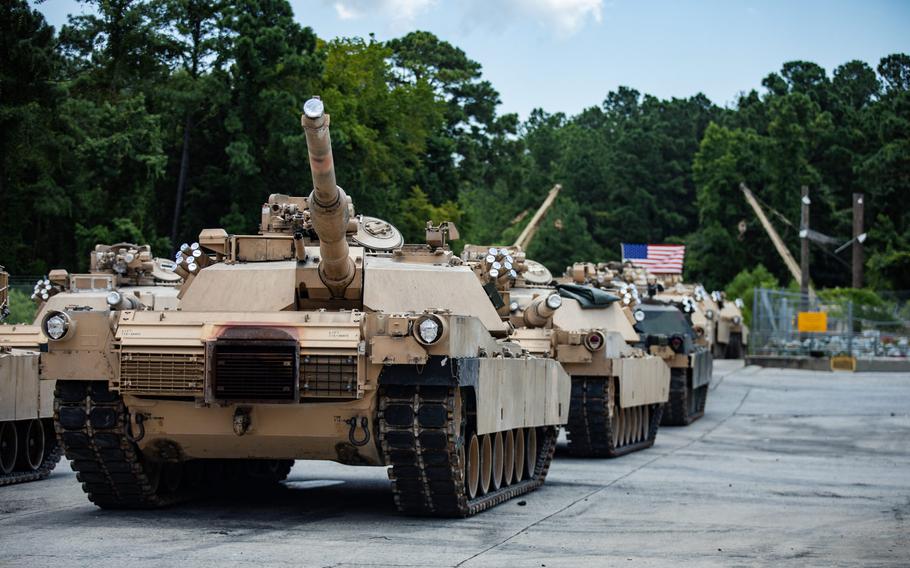
U.S. Marine Corps M1A1 Abrams tanks with 2nd Tank Battalion, 2nd Marine Division are staged in a lot on Camp Lejeune, N.C., July 27, 2020. After serving 2nd MARDIV for more than three-quarters of a century, 2nd Tank Battalion will deactivate as part of the Marine Corps' modernization plan. (Patrick King/U.S. Marine Corps)
Marine Corps M1A1 Abrams tanks of the 2nd Tank Battalion left Camp Lejeune, N.C., for the last time this week as part of the service’s sweeping modernization plan that envisions a more agile force.
Tank units on the East and West coasts shuttered this month and began hauling their armor to military depots, the service said.
The Marine Corps will eventually divest of all three of its active tank battalions as it moves from a “second land army” back to its maritime roots of defending ships at sea, island-hopping and battling for contested coastlines, in preparation for potential conflict with near-peer adversaries such as China.
“We have sufficient evidence to conclude that this capability, despite its long and honorable history in the wars of the past, is operationally unsuitable for our highest-priority challenges in the future,” Commandant Gen. David Berger wrote of the tanks in a March plan for the service’s overhaul. “Heavy ground armor capability will continue to be provided by the U.S. Army.”
The Corps also plans to trim some 12,000 troops from its ranks by 2030, eliminate law enforcement units, slash the number of cannon artillery battalions, reduce and restructure infantry battalions, and disband many manned aviation units. It will instead build up light armored reconnaissance units, drone squadrons and long-range precision strike capabilities — plans call for the tripling of rocket artillery battalions — among other changes.
And the service isn’t dallying. Early this month, the 1st Tank Battalion at Twentynine Palms, Calif., said goodbye to its tanks. Weeks later, Alpha Company, 4th Tank Battalion cased its colors down the road at Camp Pendleton, the first of the Marine Corps Reserve battalion’s six companies expected to do so by the end of 2021. Last week, some 200 West Coast-based Abrams tanks, M-88 Recovery Vehicles and other equipment began moving through the Corps’ logistics base in Barstow, Calif., en route to Army depots in California and Alabama.
Hundreds of Marines in tank units will be able to change specialties or transfer into the Army to continue serving as tankers, and those with at least 15 years of service may apply for early retirement, the service has said.
“Remember that our tanks were just weapon systems, albeit a damn fine weapon system,” Capt. Mark Rothcock, Alpha Company commander, said at a July 18 deactivation ceremony. “You individual Marines were always the key to the company’s success.”
On the East Coast, 2nd Tank Battalion’s Charlie Company cased its colors last Friday, where company commander Capt. John Fergerson recalled the role its tanks played in the second battle for Fallujah in Iraq in 2004.
The decision to do away with tanks does not diminish their value in past conflicts, the service’s top officials have said. They just won’t be a part of the Corps’ future.
The tank units aren’t the only ones packing up. Three combat logistics units in California, North Carolina and Japan also shut down this summer, along with an engineer support battalion and Marine wing support group, both based in California.
“If I were to use one trait to describe the Marine Corps, it would be adaptable,” said 4th Tank Battalion commander Lt. Col. Michael D. O’Quin, citing the service’s history, during Alpha Company’s deactivation. “Now is no different. We will adapt.”
garland.chad@stripes.com Twitter: @chadgarland